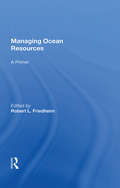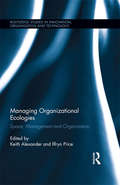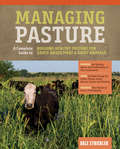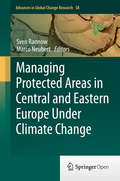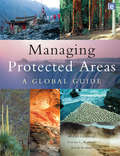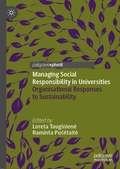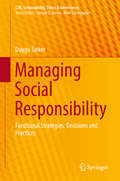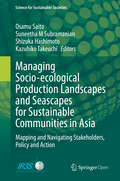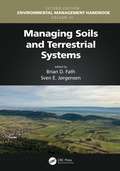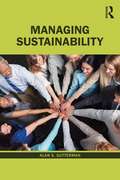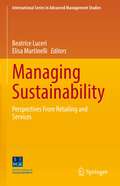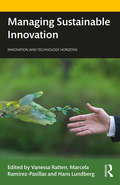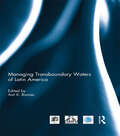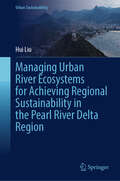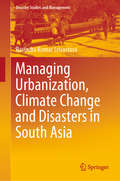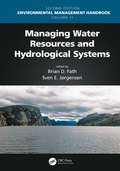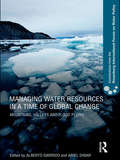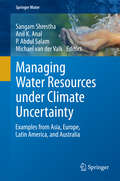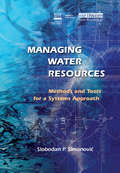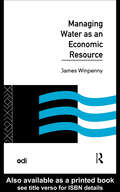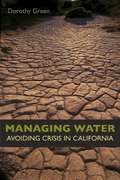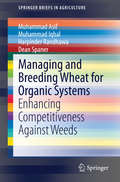- Table View
- List View
Managing Ocean Resources: a Primer
by Robert L FriedheimThis comprehensive collection of data and theory provides an essential resource base for intelligent ocean-management decisions. The book begins with essays on ocean science and technology, social and political organization theory relating to the oceans, and some of the problems of extracting energy from the oceans and monitoring oceans from space.
Managing Organizational Ecologies: Space, Management, and Organizations (Routledge Studies in Innovation, Organizations and Technology)
by Keith Alexander Ilfryn PriceThe term Facilities Management has become global but fraught with confusion as to what the term signifies. For some, notably in the USA, Facilities Management remains a discipline of human ecology. Elsewhere the term has become conflated with an alternative meaning: providing or outsourcing the provision of various services essential to the operation of particular buildings. This volume redresses that imbalance to remind Facilities Management of its roots, presenting evidence of Facilities Management success stories that engage the wider objectives of the organizations they serve, and engaging students, scholars and critical practitioners of general management with an appreciation of the power and influence of physical space and its place in the theory and practice of organizations. This book includes management perspectives from outside the field to ensure that the issues raised are seen in an organizational and management context, informing debate within the Facilities Management fraternity. It draws on human ecology and the perspective of the firm as, itself, an intra-organizational ecology of social constructs. The ecology of a firm is not restricted to the firm’s boundaries. It extends to wider relationships between the firm and its stakeholders including, in an age of outsourced building services, the Facilities Management supply chain. This volume offers arguments and evidence that managing such constructs is a key role for Facilities Management and an important participant in the provision of truly usable spaces.
Managing Pasture: A Complete Guide to Building Healthy Pasture for Grass-Based Meat & Dairy Animals
by Dale StricklerThe health and profitability of grass-based livestock begins with the food they eat. In Managing Pasture, author Dale Strickler guides farmers and ranchers through the practical and ideological considerations behind caring for the land as a key part of running a successful grass-based operation, from the profitability of replacing expensive grain feed with nutrient-rich native grasses to the benefits of ecologically-minded land management. In-depth examinations of the biology and benefits of grazing plants and different grazing strategies accompany detailed plans for paddock and fencing set-ups, livestock watering, and effective methods for dealing with common pasture problems throughout the seasons, from mud to drought. For readers invested in pasture improvement strategies that offer environmental benefits beyond better meat and dairy, including carbon sequestration, erosion prevention, increased pollinator resources and wildlife habitat, and improved water quality, Managing Pasture is an approachable, accessible guide to creating and caring for the grassland that feeds animals and future generations. This publication conforms to the EPUB Accessibility specification at WCAG 2.0 Level AA.
Managing Projects in Developing Countries
by John W. Cusworth T. R. FranksCovers the concepts, systems and skills of project management, identifying the three major elements of organisations: implementation, planning and procurement.
Managing Protected Areas in Central and Eastern Europe Under Climate Change
by Sven Rannow Marco NeubertBeginning with an overview of data and concepts developed in the EU-project HABIT-CHANGE, this book addresses the need for sharing knowledge and experience in the field of biodiversity conservation and climate change. There is an urgent need to build capacity in protected areas to monitor, assess, manage and report the effects of climate change and their interaction with other pressures. The contributors identify barriers to the adaptation of conservation management, such as the mismatch between planning reality and the decision context at site level. Short and vivid descriptions of case studies, drawn from investigation areas all over Central and Eastern Europe, illustrate both the local impacts of climate change and their consequences for future management. These focus on ecosystems most vulnerable to changes in climatic conditions, including alpine areas, wetlands, forests, lowland grasslands and coastal areas. The case studies demonstrate the application of adaptation strategies in protected areas like National Parks, Biosphere Reserves and Natural Parks, and reflect the potential benefits as well as existing obstacles. A general section provides the necessary background information on climate trends and their effects on abiotic and biotic components. Often, the parties to policy change and conservation management, including managers, land users and stakeholders, lack both expertise and incentives to undertake adaptation activities. The authors recognise that achieving the needed changes in behavior - habit - is as much a social learning process as a matter of science-based procedure. They describe the implementation of modeling, impact assessment and monitoring of climate conditions, and show how the results can support efforts to increase stakeholder involvement in local adaptation strategies. The book concludes by pointing out the need for more work to communicate the cross-sectoral nature of biodiversity protection, the value of well-informed planning in the long-term process of adaptation, the definition of acceptable change, and the motivational value of exchanging experience and examples of good practice.
Managing Protected Areas: A Global Guide
by Michael Lockwood Ashish Kothari Graeme L. WorboysThis handbook, produced by world renowned experts from the World Conservation Union (IUCN), spans the full terrain of protected area management and is the international benchmark for the field. The book employs dozens of detailed international cases studies, hundreds of concise topical snapshots, maps, tables, illustrations and a colour plate section, as well as evaluation tools, checklists and numerous appendices to cover all aspects of park management from biodiversity to natural heritage to financial management. The book establishes a conceptual underpinning for protected area management, presents guiding principles for the 21st century, reflects recent work on international best practice and provides an assessment of skills required by professionals. As the most authoritative guide ever compiled to the principles and practice of protected area management, this volume is essential for all professionals and students in all countries and contexts.
Managing Protected Areas: People and Places
by Richard Clarke Niall Finneran Denise HewlettThis open access book brings together 16 specially commissioned chapters drawn from a range of different professional-practitioner and academic global perspectives on the importance of the relationship between people and green and blue spaces. It focuses on issues surrounding the importance of natural environments on public health and wellbeing, and the environmental, cultural, and social importance of green and blue spaces that can result through responsible and sustainable adaptive management processes. It explores how the Covid-19 pandemic forced reconsiderations of our relationship with these natural spaces and highlights the important impact of the pace of climate change. While not pretending to have the answers, the stimulating and imaginative contributions embrace rich perspectives drawn from backgrounds as diverse as heritage studies, tourism, conservation, geography, policy formulation, public health, environmental health, research methods, history, literature, art, and theology.
Managing Social Responsibility in Universities: Organisational Responses to Sustainability
by Loreta Tauginienė Raminta PučėtaitėThis book explores the concept of university social responsibility, drawing on a wide range of geographical perspectives, such as China and Germany. It also examines the diverse aspirations of universities, from preserving authenticity and safeguarding Catholic values, to embedding sustainability into the community. It provides a storytelling framework for teaching sustainability in management education as an approach to strengthening the social role of universities and showcases how a service-learning approach could promote the engagement of universities within the community. This book is valuable reading for academics who are researching sustainability management, corporate and organisational social responsibility and other related social sciences. It has interdisciplinary appeal for scholars and serves interesting for practitioners.
Managing Social Responsibility: Functional Strategies, Decisions and Practices (CSR, Sustainability, Ethics & Governance)
by Duygu TurkerThis book explores how business organizations incorporate socially responsible approaches into their diverse functional strategies, decisions, and practices. It analyzes the nature and dynamics of each function as well as their specific characteristics in the formulation of sustainable strategies and decisions. As such, the book comprehensively aligns recent approaches on social responsibility and sustainability with real-world practices.By viewing corporate social responsibility (CSR) as the catalyzer of United Nations’ Sustainable Development Goals (SDGs) at the organizational level, this book introduces readers to the latest thinking and best practices towards the accomplishment of those overarching goals of humanity. Cases and examples from production, marketing, finance, accounting, human resources, and all parts of the enterprise make this book a valuable resource for scholars, students, up-and-coming managers and practitioners alike.
Managing Socio-ecological Production Landscapes and Seascapes for Sustainable Communities in Asia: Mapping and Navigating Stakeholders, Policy and Action (Science for Sustainable Societies)
by Osamu Saito Kazuhiko Takeuchi Suneetha M Subramanian Shizuka HashimotoThis open access book presents up-to-date analyses of community-based approaches to sustainable resource management of SEPLS (socio-ecological production landscapes and seascapes) in areas where a harmonious relationship between the natural environment and the people who inhabit it is essential to ensure community and environmental well-being as well as to build resilience in the ecosystems that support this well-being. Understanding SEPLS and the forces of change that can weaken their resilience requires the integration of knowledge across a wide range of academic disciplines as well as from indigenous knowledge and experience. Moreover, given the wide variation in the socio-ecological makeup of SEPLS around the globe, as well as in their political and economic contexts, individual communities will be at the forefront of developing the measures appropriate for their unique circumstances. This in turn requires robust communication systems and broad participatory approaches.Sustainability science (SuS) research is highly integrated, participatory and solutions driven, and as such is well suited to the study of SEPLS. Through case studies, literature reviews and SuS analyses, the book explores various approaches to stakeholder participation, policy development and appropriate action for the future of SEPLS. It provides communities, researchers and decision-makers at various levels with new tools and strategies for exploring scenarios and creating future visions for sustainable societies.
Managing Soils and Terrestrial Systems
by Brian D. Fath Sven E. JørgensenBringing together a wealth of knowledge, Environmental Management Handbook, Second Edition, gives a comprehensive overview of environmental problems, their sources, their assessment, and their solutions. Through in-depth entries and a topical table of contents, readers will quickly find answers to questions about environmental problems and their corresponding management issues. This six-volume set is a reimagining of the award-winning Encyclopedia of Environmental Management, published in 2013, and features insights from more than 400 contributors, all experts in their field. The experience, evidence, methods, and models used in studying environmental management are presented here in six stand-alone volumes, arranged along the major environmental systems. Features The first handbook that demonstrates the key processes and provisions for enhancing environmental management Addresses new and cutting-edge topics on ecosystem services, resilience, sustainability, food–energy–water nexus, socio-ecological systems, and more Provides an excellent basic knowledge on environmental systems, explains how these systems function, and offers strategies on how to best manage them Includes the most important problems and solutions facing environmental management today In this third volume, Managing Soils and Terrestrial Systems, the general concepts and processes of the geosphere with its related soil and terrestrial systems are introduced. It explains how these systems function and provides strategies on how to best manage them. It serves as an excellent resource for finding basic knowledge on the geosphere systems and includes important problems and solutions that environmental managers face today. This book practically demonstrates the key processes, methods, and models used in studying environmental management.
Managing Sustainability
by Alan S. GuttermanManaging Sustainability is a comprehensive guide to governing, leading, and managing a successful sustainability-focused business. Being a socially and environmentally responsible business is a worthy goal for many people; however, turning the goal into reality is a daunting process. This book takes a clear and practical approach to the “nuts-and-bolt” of achieving this goal, and covers steps to be taken by directors and executives to create and implement appropriate strategies, policies, and management systems. It recognizes that corporate social responsibility (“CSR”) is like any other important management initiative and requires proactive leadership from the top of the organization. Key topics include: • Understanding how CSR is changing the traditional fiduciary duties of directors and officers • Developing and implementing internal governance instruments to provide a foundation for decision-making around CSR • Integrating CSR into the duties and responsibilities of the chief executive officer and other members of the C-suite team, as well as into their compensation arrangements • Conducting continuous audits and assessments of the sustainability governance and management framework using certification and rating systems to evaluate and improve CSR performance and effectiveness Current and aspiring leaders wishing to build a sustainability-centered business will appreciate the straightforward and actionable guidance offered by this book.
Managing Sustainability: Perspectives From Retailing and Services (International Series in Advanced Management Studies)
by Beatrice Luceri Elisa MartinelliCompanies and policy makers are prioritizing environmental, social, and governance goals as part of their strategies. Academic research has started to focus on these issues, but many important matters require deeper investigation and reflection, especially in specific sectors. This book focuses on the sustainability issues within the retailing and services sectors. Starting the discussion around research-knowledge on CSR, the authors discuss the strategic aspects of managing sustainability in retailing and service companies and offer recommendations to effectively manage the marketing levers for sustainability. Readers will benefit from an in-depth analysis of the social responsibility practices of major retailers and their strategies. The authors also take an inside view of CSR by studying the angles of employee perception and job satisfaction, financial performance, and the more recent impact of COVID-19. Using this approach, they highlight the system of relationships existing between stakeholder-related concepts and organizational factors and how they affect sustainability strategy.
Managing Sustainable Innovation (Innovation and Technology Horizons)
by Vanessa Ratten Marcela Ramirez-Pasillas Hans LundbergThis book is an insightful text looking at sustainable innovation and the emerging fourth sector, i.e. hybrid organizations, through an interdisciplinary approach. The book illuminates what hybrid organizations are and how they generate new ways of creating blended value to secure the well-being of future generations and preservation of ecological services. The book also discusses how sustainable innovation may offer creative solutions to societal issues, the sharing economy and the circular economy. This book will appeal to those taking MBA and EMBA programmes, and those with an interest in creating sustainable business and innovation solutions.
Managing Transboundary Waters of Latin America (Routledge Special Issues on Water Policy and Governance)
by Asit K. BiswasDefinitive analyses of transboundary water management in Latin America are conspicuous by their absence. The situation is a little better for rivers compared to groundwater resources. Transboundary water management in Latin America has been evolving in a somewhat different manner compared to other continents.The book includes eight authoritative case studies of Latin American transboundary rivers and aquifers, as well as a thinkpiece on the complexities of managing aquifers based on global experiences. The case studies are of different scales, ranging from the mighty Amazon to small Silala. The overall focus of the book is on ways in which such difficult and complex rivers and aquifers that are shared by two or more countries can be managed efficiently and equitably, and on the lessons, both positive and negative, that other regions can learn from the Latin American experience.This book was published as a special issue of the International Journal of Water Resources Development.
Managing Urban River Ecosystems for Achieving Regional Sustainability in the Pearl River Delta Region (Urban Sustainability)
by Hui LiuThis book provides a systematic understanding of urban river management from the perspective of ecosystem health in the Pearl River Delta region of China, where rapid socio-economic development happens together with exploitation and pollution of the natural environment. Urban rivers, which used to support navigation and provide water resources to humans, now suffer from various kinds of ecosystem degradation and thus create threats to regional sustainability. This book treats the urban river as an ecosystem which closely relates to and interacts with humans and defines urban river ecosystem health as a requirement at three levels: sensorial fitness, living water, and affinity with humans, which emphasizes more on the human-oriented needs. The evolution processes of urban river ecosystem health protection can generally be divided into four phases, demonstrating the relationships between human activities and UREH status as simple balance, uncontrolled imbalance, continuous interlocking, and stable harmony. The relationships between typical urban rivers and humans in the Pearl River Delta region, China, are then analyzed on both regional and local scales and from lateral, time-longitudinal, and spatial dimensions. Intensive human activities, together with the intrinsic complex and high-density river network, result in deteriorating water quality, changing hydrological conditions, and damaging the river ecosystem in this region. From the perspective of political ecology, various actors in urban river management include governmental agencies, business, multilateral institutions, ENGOs, and grassroots actors, whose unequal power relations vary over time and space, causing conflicts as well as coordination. Especially, different governmental agencies are engaged, resulting into overlap and gap among their functions as well as spatial discrepancy. River Chief System, as a new practice of urban river management, has strengthened the collaboration effect and got success in river pollution control. The spatial scale effect of human activities on urban river water quality is examined, implying the necessity of adopting a unified management strategy at the buffer zone scale to protect and restore urban river ecosystem health. The target audience of this book includes postgraduate students and researchers who have research interests in, as well as government officers, whose routine is related to water management.
Managing Urbanization, Climate Change and Disasters in South Asia (Disaster Studies and Management)
by Ravindra Kumar SrivastavaThis book offers essential insights into potential catastrophic events that might befall upon the emerging urban landscape in South Asia, and which are due to hazards, risks and vulnerabilities inherent in the region’s geophysical location, as well as due to climate change and unplanned urbanization. It highlights major physio-graphic, demographic, geological and geophysical indicators that are responsible for changing the pattern and trend of urbanization in South Asia – a crucial issue in view of emerging threats of climate change, and changes in the demographic profile. The book addresses the disaster management scenario in South Asia, manifestations of climate change in the region and various urban setups under climate-change-induced risks. Further, it elaborates on the challenges of urbanization-based neo-risks and vulnerabilities, which manifest in the form of slum area growth, piling and littering of waste and filth, new health risks, groundwater contamination, air pollution, highly energy-dependent lifestyles, poverty, socio-economic tensions, etc. It also critically examines the institutional mechanisms for disaster risk reduction (DRR), climate change adaptation (CCA) and urban governance, and suggests appropriate changes in the governing structure to mitigate these risks. The book draws the attention of urban planners and policymakers to current shortcomings in the administrative and financial structures of local urban bodies. While outlining climate-associated risks and adaptation strategies in South Asia, it also suggests measures for integrating climate change and urban adaption with state's planning processes, and puts forward a risk alleviation platform to bring the risk managers working in different fields together, so that they make concerted efforts to achieve sustainable development. It offers valuable takeaways for researchers, urban planners, those working in industry, consultants, and policymakers.
Managing Visitor Experiences in Nature-based Tourism
by Haywantee Ramkissoon Brent Lovelock Mary E. Allen Robert C. Burns Azizul Hassan Peter Fredman Ali Thompson Mick Abbott Karl Agius George Ariya Rocío Blanco-Gregory Cameron Boyle Kadir Çakar Eugenio Conti Fernando Enseñat-Soberanis Sonia Ferrari Stuart Hayes Nicolaia Iaffaldano Woody Lee Tiago Lopes Andrés Ried Luci Lusine Margaryan Johnathan Mondragón-Mejía Ana Goytia Prat Francisco Silva Jeffrey C. Skibins Ismail UzutThis book focuses on the experiences of tourists visiting nature-based destinations, exploring current knowledge and providing insights into conceptual issues through the use of empirical evidence from five continents. Presented as three topics, the contents discuss tourism and nature-based experiences by looking at the role and relevance of nature and the uniqueness of such experiences. The book identifies visitor management challenges and provides explanations for the solutions reached. The final section takes a more overarching destination management perspective that transcends the tourism product or business level and focuses on destination and generic issues like indicators or marketing implications. The book also includes research-based case studies which contribute to an overall understanding of the core issues involved in managing visitor experiences in nature-based tourism.
Managing Water Resources and Hydrological Systems
by Brian D. Fath Sven E. JørgensenBringing together a wealth of knowledge, Environmental Management Handbook, Second Edition, gives a comprehensive overview of environmental problems, their sources, their assessment, and their solutions. Through in-depth entries and a topical table of contents, readers will quickly find answers to questions about environmental problems and their corresponding management issues. This six-volume set is a reimagining of the award-winning Encyclopedia of Environmental Management, published in 2013, and features insights from more than 400 contributors, all experts in their field. The experience, evidence, methods, and models used in studying environmental management are presented here in six stand-alone volumes, arranged along the major environmental systems. Features The first handbook that demonstrates the key processes and provisions for enhancing environmental management Addresses new and cutting-edge topics on ecosystem services, resilience, sustainability, food–energy–water nexus, socio-ecological systems, and more Provides an excellent basic knowledge on environmental systems, explains how these systems function, and offers strategies on how to best manage them Includes the most important problems and solutions facing environmental management today In this fourth volume, Managing Water Resources and Hydrological Systems, the reader is introduced to the general concepts and processes of the hydrosphere with its water resources and hydrological systems. This volume serves as an excellent resource for finding basic knowledge on the hydrosphere systems and includes important problems and solutions that environmental managers face today. This book practically demonstrates the key processes, methods, and models used in studying environmental management.
Managing Water Resources in a Time of Global Change: Contributions from the Rosenberg International Forum on Water Policy (Contributions from the Rosenberg International Forum on Water Policy)
by Alberto Garrido Ariel DinarGlobal change possesses serious challenges for water managers and scientists. In mountain areas, where water supplies for half of the world population originate, climate and hydrologic models are still subject to considerable uncertainty. And yet, critical decisions have to be taken to ensure adequate and safe water supplies to billions of people, millions of farmers and industries, without further deteriorating rivers and water bodies. While global warming is known to cause glaciers’ retreat and reduced snow packs around the world, it is not clear that mountain discharge will be lower. What is widely recognised is that water management must be adapted to accommodate significant regime changes. However, this inevitably involves managing transboundary rivers, adding further complexity to putting principles in practice. This book takes global warming and the importance of mountain areas in world water resources as the starting point. First, it provides detailed reviews of the processes going on in several rivers systems and world regions in Europe (Rhône and Ebro), North America (Canadian Rockies, Western US and Mexico), the Middle East (Jordan), Africa (Tunisia, Kenya and South Africa). These contexts provide case studies and examples that show the difficulties and potential for adaptation to global change. Land-use, economics, numerous modeling approaches are some of the cross-cutting issues covered in the chapters. The volume also includes the views of water practitioners, with two chapters authored by members of the US-Canada International Joint Commission, an industrialist from Western Canada and an environmental leader in Spain. By combining a rich set of contexts and approaches, the volume succeeds in offering a view of the global challenges faced by water agencies, international donors and researchers around the world. A case is made in some chapters to seek adaptive strategies rather than trying to reduce or control resources variability. This requires factoring in land-use, social and economic aspects, especially in developing countries. Another conclusion is that complex problems can and must be posed and negotiated with the help of models, mapping techniques and science-based facts. However complex these may be, there are ways to translate them to easily interpretable and visualisations of alternative scenarios and courses of action. This book provides numerous examples of the potential of such approaches to draft environmental programmes solve transboundary disputes and reduce the economic consequences of droughts and climate instability.
Managing Water Resources under Climate Uncertainty
by Anil K. Anal Sangam Shrestha P. Abdul Salam Michael van der ValkThis book aims to come up with views to address the queries of planners, policymakers, and general people for water resources management under uncertainty of climate change, including examples from Asia and Europe with successful adaptive measures to change the challenge of climate change into opportunities. The availability of clean water is a major global challenge for the future due to a rapidly growing population and urbanization where further stress in water resources is expected due to the impact of climate change. The wide range of impacts includes for example changes in hydrology, moisture availability, spatial and temporal variations in magnitude of stream flow, and dwindling of water levels with adverse effect on wetlands and ecosystem. As a consequence, water management has become a serious issue and was identified as a global societal challenge, and climate change forecasting has become one of the key issues in recent research on sustainable water resources management.
Managing Water Resources: Methods and Tools for a Systems Approach
by Slobodan P. Simonovic'This book bridges disciplines, previously confined to specialist journal publications, by providing a comprehensive overview of the systems analysis application to water resources. It is ideal for Masters-level courses in Water Resources Engineering where modern management techniques of optimization and modelling are highly important in the strategic management of a vital resource.' - Derek Clarke, University of Southampton, UK 'The great novelty of this book is that it presents in detail how fuzzy-set theory can be used in water resource system management. The author was one of the pioneers who opened up this new field and is considered to be one of the greatest experts in it.' - Rodolfo Soncini Sessa, Politecnico di Milano, Italy Water resources management is increasingly interdisciplinary and must take into account complex socioeconomic factors and environmental variables. This book describes the 'systems approach' and its application to contemporary water resources management, focusing on three main sets of tools: simulation, optimization and multi-objective analysis. This approach is presented within the context of sustainable planning and development under conditions of uncertainty. Managing Water Resources: Methods and Tools for a Systems Approach introduces system dynamic simulation as a tool for integrated modelling and contains coverage of the use of fuzzy sets for incorporating objective and subjective uncertainties. The book combines theory with many practical examples, as well as including programs and exercises on downloadable resources. It comprises both an advanced text for students of water resources and civil or environmental engineering and a practical guide for professionals. Published jointly with UNESCO and International Hydrological Programme
Managing Water as an Economic Resource (Development Policy Studies Series)
by James WinpennyWater, already a scarce resource, is treated as though it were plentiful and free. The task of supplying enough water of the required quality to growing populations is straining authorities and governments to the limit as the economic and environmental costs of new supply sources escalate and wasteful supply, delivery and consumption systems persist. Managing Water as an Economic Resource argues that the root of the crisis is the failure of suppliers and consumers to treat water as a scarce commodity with an economic value. James Winpenny evaluates policies for the improved management of existing demand, and draws on case studies from different countries as he discusses how policies could be implemented to treat water as an economic good conferring major economic, financial and environmental benefits.
Managing Water: Avoiding Crisis in California
by Dorothy GreenDorothy Green gathers detailed information on its water systems and applies the lessons learned from this data statewide. A useful primer on watershed and water policy issues, this book provides reasoned, thoughtful, and insightful arguments about sustainability.
Managing and Breeding Wheat for Organic Systems
by Muhammad Asif Muhammad Iqbal Harpinder Randhawa Dean SpanerGenetically uniform cultivars in many self-pollinated cereal crops dominate commercial production in high-input environments especially due to their high grain yields and wide geographical adaptation. These cultivars generally perform well under favorable and high-input farming systems but their optimal performance cannot be achieved on marginal/organic lands or without the use of external chemical inputs (fertilizers, herbicides and pesticides). Cereal breeding programs aim at evaluating candidate lines/cultivars for agronomic, disease and quality traits in a weed free environment that makes it impossible to identify traits conferring competitive ability against weeds. Moreover, quantification of competitive ability is a complex phenomenon which is affected by range of growth traits. Above (e. g. light) and below (e. g. water and nutrients) ground resources also influence competitiveness to a greater extent. Competitiveness is quantitatively inherited trait which is heavily influenced by many factors including genotype, management, environment and their interaction. Sound plant breeding techniques and good experimental designs are prerequisites for maximizing genetic gains to breed cultivars for organically managed lands. The brief is focused on breeding wheat for enhanced competitive ability along with other agronomic, genetic and molecular studies that have been undertaken to improve weed suppression, disease resistance and quality in organically managed lands. The examples from other cereals have also been highlighted to compare wheat with other cereal crops.
